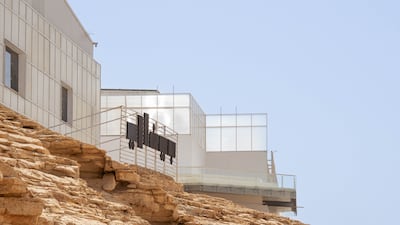The Diriyah Contemporary Art Biennale will launch on January 30 with a procession, musicians and a line of Toyota pick-ups moving through the historic region north-west of Riyadh, before arriving at the Jax district, the venue of the event, and culminating with poetry readings and performances.
This procession is not just fanfare. It will explicitly – and ceremoniously – underscore the theme of the third biennale. Its title, In Interludes and Transitions, is inspired by a colloquial Arabic phrase that alludes to the routines of encampment and journeys of the peninsula’s nomadic communities.
“The Arabic sentence evokes this constant settling and moving, and the continuity and solidarity within that,” says Nora Razian, one of the two artistic directors of the biennale. “The English title refers to musical scores or theatrical kind of acts or interludes. We wanted to refer to oral histories, music and rhythms and how they influenced how we put the Biennale together, as well as how we crafted the visitor experience.”

Starting with Toyota pick-ups fits culturally, as they have long been the preferred utilitarian vehicle of choice for many Bedouins from the region, replacing dromedaries as the dependable ship of the desert.
“They are the vehicle of choice for processions and moving through spaces,” Razian says. “The procession is looking at how these ideas of movement and celebration have also changed through working with cars, and what the car symbolises in popular culture.”
The procession, Razian says, is a commissioned work by Mohammed Alhamdan, an artist and music producer known by his moniker, 7amdan. “He’s really embedded in pop culture in Saudi,” she says. “He’s quite a big figure. He’s working with different musicians and poets to produce this procession. It will be a real treat, sonically and visually.”
At the same time, this procession will lend itself, symbolically, to the other types of movements and migrations the biennale will explore.
“The opening ceremony gestures towards that, but hoping that the entire course of the Biennale is a site through which multiple processions can be invoked,” Sabih Ahmed, who is also the biennale’s artistic director, says.
“All of these movements are so entangled, whether it's the movement of elements or the movement of societies and communities, sometimes by choice, sometimes in exile. It can be the movement of histories that are carried through those bodies and in songs that get translated and transformed in other spaces.”
The biennale has unveiled a preliminary list of the participating artists. They include Pio Abad, Rand Abdul Jabbar, Yussef Agbo-Ola (Olaniyi Studio), Ahaad Alamoudi, Afra Al Dhaheri, Ruba Al-Sweel, Taysir Batniji, Raven Chacon, Rohini Devasher, Merve Ertufan, Ivana Franke, Rahima Gambo, Petrit Halilaj, Aziz Hazara, Alana Hunt, Yazan Khalili, George Mahashe, Theo Mercier, Nour Mobarak, Nancy Mounir, Hussein Nassereddine, Daniel Otero Torres, Thao Nguyen Phan, Gala Porras-Kim, Sarker Protick, Raqs Media Collective, Oscar Santillan, Truong Cong Tung, Wolff Architects, Agustina Woodgate, and Yu Ji.
“All of the artworks, the programmes, events and performances suggest this kind of entangled movement that is shaping the world right now. And they come with both – beautiful stories of resilience, but also of of troubled times of adversity,” Ahmed says.
Several artists will also unpack historical tensions in their works, examining their rippling effects into the modern era – these include Phan.
“Her work is around [Vietnamese sculptor] Diem Phung Thi,” Razian says. “She was a modernist who came back to Vietnam after the war. Her legacy is known between Vietnam and France. Thao Nguyen Phan’s work is essentially a dialogue with this figure who passed away [in 2002]. It is a conversation in terms of being a woman artist, making art in times of conflict and how you position yourself as an artist in those times.”
Halilaj, meanwhile, will present works that draw from his childhood memories in Kosovo.
“The work is based on his childhood sketchbook kind of made monumental, in a way monumentalising that time and history for him,” Razian says.
The scenography of the biennale, by design studio Formafantasma, will reflect on the core concepts of the biennale, applying a rhythm that will avoid strict segmentations, opting instead for the lilts and movements that comes as part of a procession.
“We choreographed it so as not to have some kind of a linear timeline,” Ahmed says. “It is spiraling, circling, pausing and moving. The exhibition is designed through various passages and arenas. There are also various live elements and performance interventions that are happening. While the exhibition is only one leg of the biennale, the performances and outdoor commissions are as integral.”
The Diriyah Contemporary Art Biennale will run between January 30 and April 23


